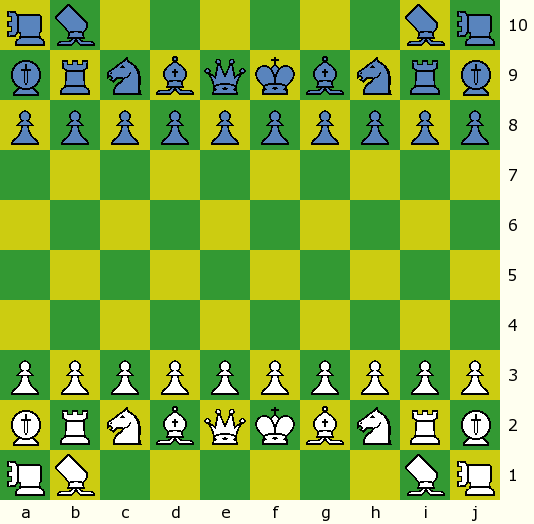Pillage
Pillage is a 10x10 board Chess variant in which each player starts off with 2 Cannons, 2 Vaos, 2 Super Pawns, 10 fast pawns, 2 knights, 2 bishops, 2 rooks, 1 queen and 1 king.
 |
The two armies are as close to each other as in traditional chess making early tactical attacks just as or even more likely.
Cannons on a1/a10 j1/j10. |
Pieces
Cannon - When the Cannon does not take, it moves like a Rook, i.e., on an orthogonal line an arbitrary number of empty squares. When it takes, it must jump: when taking, the Cannon also moves over an orthogonal line, jumps over the first piece it meets (which may either be friendly or from the opponent) and then continues over the line until the next piece it sees: if that is from the opponent, the Cannon can take it by moving to that position.... more info
Vao - When it isn't capturing, it moves like a Bishop; when it does capture, it moves diagonally like a Bishop, except that it must jump over a single intervening piece, which may belong to any player. It moves like a Bishop until it reaches this piece, leaps over it, and continues moving like a Bishop until it captures its target. When it isn't capturing, it may not leap; and it may not capture without leaping.
...more info
Super Pawn - The Super Pawn can move 1 space or jump 2 spaces: sideways or diagonally forward or straight ahead. (E,W,NE,NW,N) Note that like a regular pawn it cannot go backwards.
It captures by replacement and jumped over enemy pieces are unaffected.
En-passant rules do not apply, and it promotes to any piece just like a regular pawn.
Fast Pawn - The pawn's move is modified slightly to make it stronger and faster. The pawn can move 1 or 2 spaces forward anytime. (It cannot jump.)
A pawn can capture en-passant an enemy pawn that made a double space move to bypass it.
Rules
Other than Flexible Castling, the new pieces and faster pawn movement, the game rules are as in orthodox chess.
Pawn Movement:The pawn's move is modified slightly to make it stronger and faster.
The pawn can move 1 or 2 spaces forward anytime.
A pawn can capture en-passant an enemy pawn that made a double space move to bypass it.
Castling:
The game utilizes flexible castling, which enables the king and rook to choose from 7 castling positions. The king and rook must be adjacent to each other after castling and the king cannot be in check or pass over attacked squares during castling.
Castling can be done by moving the king 1-3 (or 4 on Q-side) spaces towards the rook and moving the rook over and next to it.
The most extreme wing castling occurs with the king moving 3 spaces (or 4 spaces on q-side) to the rook's square while the rook moves 1 space towards the king.
Conversely the most centralized rook castling involves the king moving just 1 space words the rook and the rook filling the king's square.
Note that while there are more castling options in this game, there are also more opportunities to not castle at all! Depending on you or your opponent's plans you might simply choose to move your king to the back rank!
Play the Game!
Play Pillage! (Free Registration at chessvariants.org required).View Game Logs for Pillage
|
If you would like to email the chess variant inventor directly: inventor@chess.computerwebservices.net
|
|
Posted by: chessinventor on 2022-03-27 18:12:39 Like Chess: YES
Is this good or what!! |


